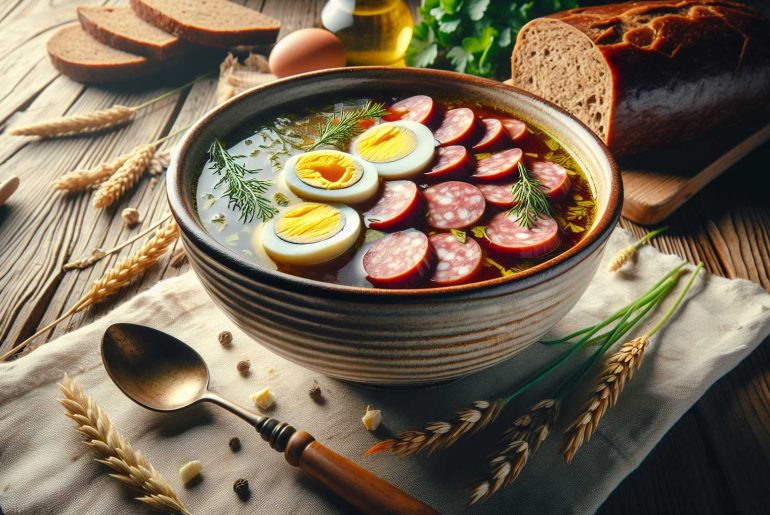
Żurek is a traditional Polish soup that combines sour rye flour with a mix of hearty ingredients, making it a unique and comforting dish. It’s especially popular during Easter, but people enjoy it all year.
This soup gives us a glimpse into Polish culture and food traditions. Let’s dive into the story behind Żurek, its main ingredients, and how people prepare and eat it.
This will help us understand why it’s such an important part of Polish culinary history.
The History of Żurek
Żurek, a sour rye soup from Poland, has roots stretching back to the medieval period. This dish showcases how Eastern Europeans creatively preserved food before modern technology. The key to Żurek’s longevity and unique taste is its base: a fermented mix of rye flour and water. This method wasn’t just about making grains last longer; it also made the soup healthier. Fermentation added vitamins and probiotics to Żurek, boosting its nutritional value.
As centuries passed, Żurek adapted to changes in what people ate and how they farmed. This soup’s story is a testament to the adaptability of Polish cuisine. It reflects how traditions can evolve, yet maintain a connection to the past. Today, Żurek serves as a delicious reminder of Poland’s culinary heritage and its people’s ability to innovate with what they have.
For anyone interested in trying Żurek, you might look for it in Polish restaurants or even try making it at home. The process of fermenting rye flour and water is simpler than you might think, and it allows you to experience a piece of culinary history firsthand. Plus, you can add your twist to it, just like generations of Poles have done, making your version of this classic soup.
Key Ingredients
Żurek, a traditional Polish soup, owes its unique taste to a few essential ingredients. The most important is fermented rye flour, which gives the soup its characteristic sour flavor. This ingredient reflects the agricultural practices and economical cooking methods that have been part of Eastern European culture for hundreds of years.
Another key ingredient is white sausage, a testament to the region’s butchery skills, adding depth and meatiness to the soup. The aroma and flavor are further enhanced by the addition of garlic, onions, and marjoram. To top it off, hard-boiled eggs and horseradish are used as garnishes, offering a textural contrast and a zesty kick.
These ingredients do more than just contribute to Żurek’s taste; they tell a story of Poland’s culinary heritage and the ingenuity of its people in using what’s locally available. For instance, the use of fermented rye flour is not just about flavor; it’s a nod to the importance of rye in the region’s agriculture and an example of how fermentation can be used to preserve and enhance food. Similarly, the inclusion of white sausage speaks to the craftsmanship of Polish butchers and the value placed on meat in the diet.
If you’re looking to recreate this dish at home, sourcing quality ingredients is key. Look for authentic Polish white sausage from a reputable butcher and consider making your own fermented rye flour for the most authentic flavor. As for the garnishes, fresh horseradish will provide a sharper, more vibrant finish than the pre-prepared kind.
Step-by-Step Recipe
Let’s dive straight into making Żurek, a traditional Polish soup known for its unique sour taste and rich history. The first step involves fermenting rye flour with water to create a mixture called zakwas. This process, which can take several days, is crucial for the soup’s distinct sour flavor and pays homage to medieval cooking techniques.
Once the zakwas is ready, we then prepare a hearty broth using either pork or poultry, which serves as the base of the soup.
Next, we add root vegetables like carrots, parsnips, and potatoes. These veggies are simmered until they’re perfectly tender, adding a comforting texture to the soup. Seasoning is key, so we’ll use garlic and marjoram to give the Żurek its signature taste. These ingredients, common in Polish cuisine, blend beautifully, creating a rich and aromatic flavor profile.
This recipe is more than just a meal; it’s a celebration of Polish culture and tradition. As you follow these steps, you’re not only preparing a delicious soup but also connecting with centuries-old culinary practices. If you’re looking for an authentic experience, consider using a traditional Polish zakwas starter, which you can find in specialty stores or online. This will ensure your Żurek has that authentic sourness and depth of flavor that makes it so beloved.
Serving Suggestions
Understanding how to serve Żurek can greatly enhance your experience of this traditional Polish soup. Żurek is known for its distinctive sour taste and hearty rye base, making the way it’s served quite important. Traditionally, this flavorful soup is poured over boiled potatoes or slices of sausage. This combination not only blends well but also brings out the soup’s unique sourness and the comforting texture of the rye.
A particularly interesting and traditional way to serve Żurek is in a hollowed-out loaf of bread. This method does more than just hold the soup; as you eat, the bread soaks up the soup, becoming a delicious part of the meal itself. It’s a creative and engaging way to enjoy Żurek, offering both a nod to Polish culinary traditions and an immersive dining experience.
For those looking to recreate this at home, sourcing a dense, crusty loaf of bread large enough to hold the soup is key. As for the soup itself, incorporating high-quality sausage and fresh potatoes will make all the difference in flavor. This approach to serving Żurek not only pays homage to its cultural roots but also turns a simple meal into an unforgettable experience.
Cultural Significance
Żurek, a sour rye soup, stands as a staple in Poland’s culinary landscape, reflecting the country’s rich history and traditions. This dish, with its simple origins, has grown and changed alongside Poland, showcasing the nation’s economic shifts and regional tastes. Particularly during Easter, Żurek takes center stage, underlining its role in Polish religious and cultural celebrations. It’s a time when families come together, strengthening their bonds over the preparation and sharing of this traditional meal. Żurek does more than fill the stomach; it unites people, reinforcing a sense of Polish identity.
The ingredients and the way people make Żurek vary from one region to another, painting a picture of Poland’s diverse climate and culinary preferences. For instance, in some areas, people might add white sausage or hard-boiled eggs, while in others, mushrooms or smoked meat are the go-to choices. These variations not only make Żurek a versatile dish but also a testament to the ingenuity and adaptability of Polish cooking. It’s as if each bowl of Żurek tells a story of the place and the people who made it, making the dish a living piece of Poland’s cultural fabric.
Conclusion
Żurek is a classic Polish soup that really shows off the country’s cooking skills and its history. It’s made with fermented rye flour, which gives it a unique sour taste that you won’t find in many other dishes. They also throw in a bunch of meats and veggies, which makes it even tastier.
What’s cool about Żurek is how it uses ingredients that are common in Poland, showing how creative Polish cooks can be. It’s more than just food; it tells a story about Poland’s past and its culture. This soup is a great example of how traditional dishes are more than just recipes; they’re a way of sharing a country’s heritage and values in a delicious way.







Comments are closed.